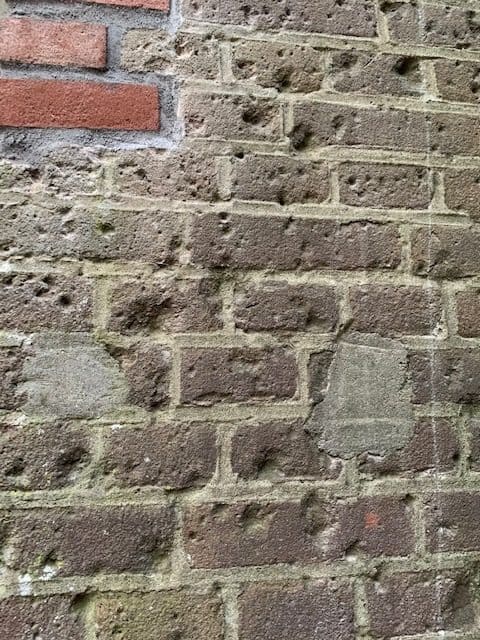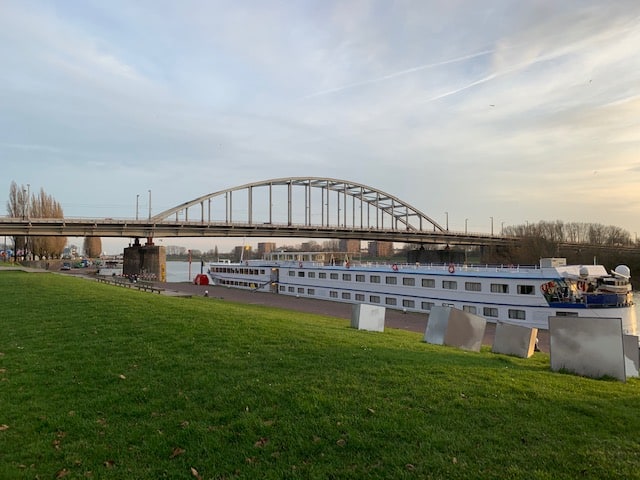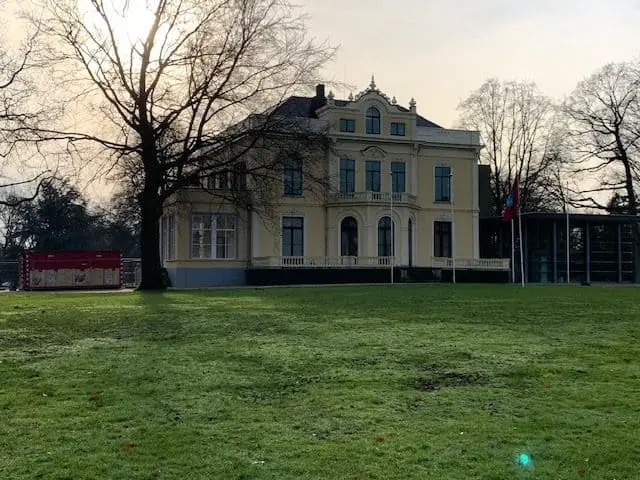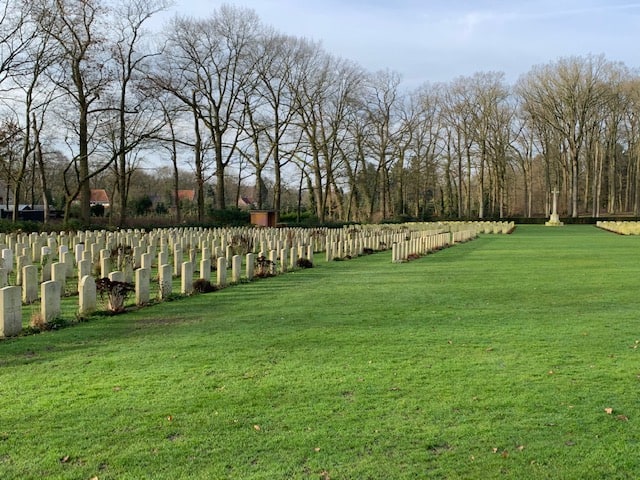I often came to Oosterbeek for a while and was intrigued by a train bridge with bullet holes from the Battle of Arnhem still in its walls. I went around Oosterbeek and Arnhem to find out what other battle traces could still be found.
I also spoke to some inhabitants of Oosterbeek who lived here in 1944 when they were children to find out what it was like to be in the middle of one of the Second World War’s fiercest battles.
In and around Arnhem, particularly in Oosterbeek, where most of the fighting occurred, plenty of landmarks still remind us of the ferocious battle here about 75 years ago. Those landmarks range from a train bridge still scattered with bullet holes to an impressive Airborn museum.
But we should not forget that equally brave men fought on the road to Arnhem to reach the paratroopers.
Battle Of Arnhem Map
In the map below, you can find the locations of battle landmarks in Arnhem and Oosterbeek. If you click on the numbers, you will get more information about these landmarks and access their websites, if there are any.
Most of the battle of Arnhem took place in Oosterbeek, a small village to the west of Arnhem.
After the battalion of British paratroopers surrendered near the Arnhem bridge, the remaining paratroopers had to withdraw to a perimeter in Oosterbeek, a tiny village west of Arnhem.
There are still scars today of the ferocious fighting in Oosterbeek during the advance to the bridge from Oosterbeek and the siege of the perimeter in Oosterbeek by the Germans.
In the walls of the little train viaduct in the middle of the Benedendorpse weg, you can still find hundreds of bullet holes of the battles that raged here in September 1944.

I learned from the inhabitants at Oosterbeek, who were here as children during the siege of the perimeter in Oosterbeek that the Germans occupied this eastern part of Oosterbeek during their siege.
Therefore, these bullet holes are probably due to the fighting during the paratroopers’ advance to the bridge when Colonel John Frost’s battalion avoided the German blocking positions a bit more north by taking the Benedendorpse Weg, close to the Rhine.
They probably met some German resistance here but could still break through and reach the bridge in Arnhem on the second day of the battle.
The Arnhem Bridge Today
The famous bridge looked relatively peaceful on a sunny winter day in The Netherlands in January 2020. It is not the original bridge anymore because the middle part of the original bridge was destroyed in October 1944 by the RAF.
However, the bridge’s foundations are still the same, and the central part of the bridge was rebuilt after the war.

About 75 years ago, in September 1944, this famous bridge was the center of a ferocious battle between British paratroopers and German SS armored divisions.
The brave British paratroopers fought a heroic fight against the German tanks. Still, they were outnumbered and outgunned because they could not match the heavy material the Germans could bring into the field against the British.
This bridge in Arnhem is now named the “John Frost Bridge” after the commander of the British battalion that came closest to the bridge but could not conquer it. The surrounding buildings around the bridge were destroyed and never rebuilt.
Therefore, ample open space around the bridge allows a phenomenal view of the bridge from the little museum called Airborne at the Bridge, which tells the story of three soldiers who fought and died at this bridge.
If in the years to come, any man says to you ‘I fought at Arnhem,’ take off your hat to him and buy him a drink, for this is the stuff of which England’s greatness is made
The Siege Of The Perimeter In Oosterbeek.
The paratroopers withdrew to a perimeter around Villa Hartenstein (in the western part of Oosterbeek), which served as the headquarters of the 1st British Airborne Division during the Battle of Arnhem.
I learned from the inhabitants of Oosterbeek that the Germans were quite close to this villa and that Villa Hartenstein took direct fire at the end of the battle.

Villa Hartenstein has been completely renovated, and the scars of the fighting cannot be seen anymore. Villa Hartenstein was rebuilt into the “Airborne Museum” and has become a remarkable monument to the British paratroopers’ heroism and gallantry.
It is now one of the most impressive museums in The Netherlands.
The Airborne Museum has become an imposing museum. It recently opened an extension in its cellars where you can relive what the paratroopers had to endure.
A visit to this museum is highly recommended, and you can much more information about the Airborne Museum in Oosterbeek on the internet.
Other parts of the perimeter of Oosterbeek that were the scene of ferocious fighting were parts of the western part of the perimeter close to the river, the Westerbouwing Heights, and the old village church of Oosterbeek.
Westerbouwing Heights was a severe strategic loss for the British paratroopers. The Germans could now cover the Rhine and surrounding land with machine guns at Westerbouwing Heights up to the destroyed train bridge at Oosterbeek.
After the Germans had conquered Westerbouwing Heights, they tried to cut off the British completely. However, they were stopped at the old village church at the Benedendorpseweg by paratroopers under the command of Major Logan.
The Airborne Cemetery In Oosterbeek.
The Airborne Cemetery is located north of Oosterbeek and has become a monument for the almost 1800 paratroopers who fought and died in this dreadful battle.
The cemetery location is now a quiet and peaceful part of Oosterbeek. However, the inhabitants of Oosterbeek told me that the northern part of Oosterbeek had the fiercest fighting during the battle. This is where the German pressure was most intense, and the paratroopers could still resist them.

The cemetery is well taken care of by the Dutch.
Every year, on the first Sunday after September 17th, the paratroopers are commemorated with solemn homage in the presence of veterans, their relatives, and thousands of Dutch citizens who want to pay tribute to these men who lost their lives fighting for our freedom.
During the commemoration, schoolchildren from surrounding municipalities will lay flowers at the graves to honor them.
What Are Good Books About The Battle Of Arnhem?
The famous quote “A bridge too far” comes from Cornelis Ryan’s book, which was appropriately called A bridge too far. The book was first published in 1974 and was used for an impressive movie released in 1977.
A more recent and, in my opinion, a much better book is “Arnhem, the Battle for the Bridges” by Antony Beevor, first published in 2018. Antony Beevor masterfully tells the story of these brave men. He points out the significant mistakes the British High Command made and the overconfidence that led to the loss of so many lives. I highly recommend this book If you want to relive those frightening days.
What Is A Good Movie About The Battle Of Arnhem?
A bridge too far is an impressive movie, but it is still romanticized. In my opinion, the best documentary on the internet about the battle of Arnhem is a documentary which is also called “a bridge too far,” which can be found below.

